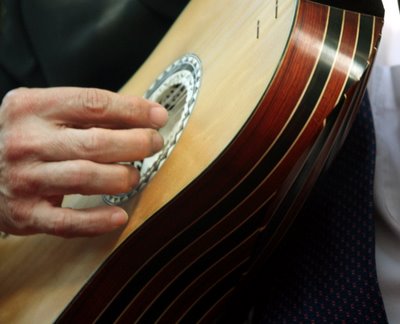
There was more Baroque on the menu at the afternoon concert at the Batha Museum. Agrupación Música presented a classic of the sacred music repertoire – The Misa Criolla.

Although the Misa has been performed for over forty years, it was given new life in the wonderful surroundings of the Batha under the leadership of flautist Enzo Gieco.
The nine member ensemble’s obvious enjoyment of the music was contagious and it took little more than a few minutes for the audience to be transported back to the 17th century and it was easy to imagine oneself in the heart of a grand Latin-American cathedral, rather than in the Medina of Fès.

The approach of the ensemble is a search for historical authenticity and yet once the ethereal atmosphere is created, there would be few but the most academic of musicologists who would be capable of critiquing the result – the work was simply transporting. Sadly the festival program is very short on detail and so I can not credit by name the various members of the ensemble, but in such an intimate environment as the Batha Museum, the connection with the audience was obvious. Again a great choice for the program and beautifully performed.
The beat of a different drum.

The evening concert was a marathon performance from the drummers from Tokyo - Za Ondekoza. The audience entered the massive Bab Makina to be greeted by a stage set with huge drums and yet, when the performance started, it was not to the sound of percussion, but a simple flute, soft as the summer breeze that played around the venue. Then, after a ritualistic flexing of muscles, one of the drummers struck an enormous drum with such force that many in the crowd were startled - the sheer volume of sound as loud as a cannon shot.

What followed was a slow build-up of varying rhythms on drums ranging in size and tone from deepest bass to a small hand-held Tibetan drums. The effect of the increasing tempo and complexity of the rhythms was mesmeric and any expectation that the crescendo had reached its peak was quickly superseded by yet another change and seemingly impossible greater speed.

There were individual stand-out performances, such as that of the female drummer, whose diminutive stature was deceptive. Once she hiked up her skirts and began her performance, her total concentration was extraordinary. At times she flayed the drum like a captured enemy, at others she almost stroked the rim of the drum in a teasing and delicate fashion, yet with the audience willing her on to even greater ferocity shortly after.

The middle section of the concert brought a change in pace and style, with the drummers having a well earned respite by indulging in a circus like performance of unusual tricks with balls, stylized children’s toys and an umbrella. The audience lapped it up.


The second female member of the Japanese troupe came on stage in a simple kimono and proceeded to perform on the koto. Her virtuosity was immediately apparent as, with a shakuhachi player alongside, she ranged from traditional Japanese folk music, through a stunning piece structured in a similar way to an abbreviated concerto, to recognisably Western melodies with a vaudevillian’s sense of humour as she accompanied the circus elements of the performance.

The final part of the concert was introduced by several of the troupe entering the audience with single small bells. As this was happening the stage was reorganised and the largest of the drums placed front and centre. The appearance of two male drummers stripped down to small loin-cloths caused a gasp of delight from the female members of an audience more used to modestly dressed musicians. However any shock soon vanished as a remarkable finale unfolded. To the delight of the audience the ensemble gathered at the front of the stage and sang unaccompanied before returning to their drums for the demanded encore.

Although taiko/Sogakuron style of drumming was not to everyone’s taste, the sheer energy of the performance commanded great respect. The notion that these performers believe in running marathon’s before performances seems incredible. For many, Za Ondekoza’s performance was a night to remember.

ALL PHOTOGRAPHS COPYRIGHT SUZANNA CLARKE 2006
Tags: Morocco Fes, Maghreb news

No comments:
Post a Comment